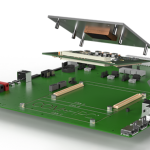Wireless technology has come a long way since its origins in radio communication. Upgrades and innovations over the decades have revolutionized the practical application of electronics by enabling connectivity without wires. This article will explore the evolution of wireless capabilities and how they have promoted transformational changes in electronic devices.
Early Days of Wireless
The first wireless technologies were developed for radio communication, primarily for military use. Early radio systems were able to transmit Morse code over distances without wires. During the early 1900s, radio communication expanded into broadcasting, allowing radio stations to transmit music and programs over the airwaves. However, early radio equipment was large and power-hungry due to the vacuum tube technology. This restricted applications to bulky fixed installations.
Miniaturization and Mobility
The invention of the transistor enabled smaller and more power-efficient wireless devices. Radios and other wireless equipment could now be made portable. With integrated circuits, wireless technology could be packed into ever-smaller chips. This allowed for handheld mobile devices with wireless capabilities, such as walkie-talkies and cordless phones. As size and power requirements decreased, wireless technology found new applications in mobile and consumer electronics.
Connectivity Explosion
Upgraded wireless standards like 3G and 4G cellular networks enabled much higher data rates compared to early technology. This allowed wireless internet access through Wi-Fi and mobile broadband. The high speeds opened the door to streaming, apps, social media and cloud services. Smartphones became the primary computer for consumers. Tablets and other devices also tapped into wireless networks for entertainment and productivity. Faster wireless transformed how people connect and access information.
Ultra-Reliable and Low Latency
Recent advances have reduced lag and improved reliability for wireless transmissions. This has enabled time-sensitive, mission-critical uses for wireless technology. Industrial settings now use wireless for monitoring and data collection. Automated guided vehicles rely on wireless signals. Medical devices leverage wireless connectivity. By becoming faster and more dependable, wireless technology can serve applications far beyond consumer electronics.
Wireless Charging
Another wireless upgrade that has changed electronics is wireless charging. Instead of plugging in cables, users can simply place devices on charging pads. Smartphones have adopted wireless charging capabilities alongside emerging technologies like smartwatches. Appliances, furniture and vehicles are integrating wireless charging too. This simple innovation promotes tremendous convenience and evolves how people interact with electronics.
Importance of Component Supply Chains
As wireless technologies continue to advance, companies like WIN SOURCE play a key role in the supply chain. WIN SOURCE maintains brand visibility and pays close attention to new component technology trends. Through professional and continuous market observation and data analysis, WIN SOURCE keeps up with the changing needs of consumers. This allows WIN SOURCE to provide the best semiconductor supply chain backup as wireless technology evolves.
The Future of Wireless
Looking forward, wireless technology will continue rapidly advancing in many areas. 5G cellular networks are still being rolled out globally, promising even faster speeds, lower latency and greater capacity compared to 4G LTE. New wireless protocols like Wi-Fi 6E will make use of the newly available 6 GHz band to provide optimized performance for home and office networks.
Innovations in areas like ambient backscatter networking, visible light communication (LiFi) and 6G research will open up new wireless capabilities and use cases. Ambient backscatter techniques allow devices to communicate by reflecting existing radio signals without needing their own radio transmitters. This enables extremely low-power wireless connections for small IoT devices. LiFi uses modulated LED light to transmit high-speed data that is unregulated and secure. 6G networks are still years away but will bring terabit speeds and new technological capabilities.
The practical applications of electronics will continue to be transformed as wireless connectivity becomes even faster, more reliable and more efficient. Near-instant communication with anyone and anywhere will be possible. Virtual and augmented reality will become seamless. Autonomous vehicles will react instantaneously. Homes, factories and cities will have ubiquitous wireless sensing and activation. The capabilities of new wireless technologies will enable innovations we can only begin to imagine today.
Conclusion
The evolution of wireless technology over decades has been pivotal in enabling our electronics-filled world. Upgrades in speed, power, efficiency and reliability have promoted the mobility, connectivity and capabilities that are integral to modern devices. As wireless continues advancing, it will shape the next generation of electronics in ways we can only begin to imagine. Reliable component suppliers like WIN SOURCE will remain essential in supporting the ongoing wireless revolution.










